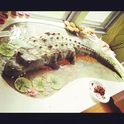Someone gave me a pint container of sourdough starter, but I have no clue how to take care of it. What do I need to do to make sure it stays
7 Comments
petitbleuJanuary 28, 2015
I agree with EmFraiche. We moved our starter across the country a couple years ago in a cooler that didn't actually stay all that cold most of the time (didn't feed it along the way). Then, I've refrigerated or frozen it for lengthy periods. I've also just neglected to feed it from time to time. Recently, I went a week between feedings at room temp, and it's still fine. I would never make bread with starter that I had been neglecting (have to feed it for several days before it's ready to bake with), but you can definitely abuse it. One of the reasons it took me so long to get into sourdough baking was that most people overcomplicate the process.
When I'm not prepping to make bread, I actually just eyeball the amounts of flour and water. I pour off most of the starter, then add some AP flour and whole wheat flour (roughly equal amounts, probably about 3/4-1 cup total). Then I add enough cool water to get a stir-able mixture (it's not runny nor very thick, but you can stir it with a spoon).
I am more precise when gearing up to make bread (I use Tartine's method--it's a great book; taught me how to make awesome sourdough bread), but while you're researching the bread-baking process, the eyeball method works just fine.
When I'm not prepping to make bread, I actually just eyeball the amounts of flour and water. I pour off most of the starter, then add some AP flour and whole wheat flour (roughly equal amounts, probably about 3/4-1 cup total). Then I add enough cool water to get a stir-able mixture (it's not runny nor very thick, but you can stir it with a spoon).
I am more precise when gearing up to make bread (I use Tartine's method--it's a great book; taught me how to make awesome sourdough bread), but while you're researching the bread-baking process, the eyeball method works just fine.
EmFraicheJanuary 27, 2015
Looks like some good resources have already been posted. In my experience, starters can take more abuse than people give them credit for. Especially if you're storing it in the fridge.
hardlikearmourJanuary 26, 2015
Ken Forkish (of Ken's Artisan Bakery and author of the book Flour Water Salt Yeast) recommends feeding a refrigerated started monthly. He uses an 80% hydration and his formula is 200 grams starter brought to room temperature, plus 100 grams whole wheat flour, plus 400 grams white flour, plus 400 grams 95º F water. Mix together, let rest covered at room temperature overnight. Remove 300 grams of starter, coat with a thin film of water, and place in a non-perforated plastic bag and refrigerate.
Lindsay-Jean H.January 26, 2015
And just for good measure, here's our guide to maintaining a sourdough starter: https://food52.com/blog...
davidpdxJanuary 26, 2015
King Arthur Flour has a useful set of instructions on maintaining the starter. http://www.kingarthurflour...
JJanuary 26, 2015
I've actually been wanting to make my own starter for a while, but now that I have one, I would really like some simple guide on how to feed it, and how to make sure it stays stable.
Sam1148January 26, 2015
You'll use it a few times. And then like me forget to feed it..and then you'll toss it out.
Heck, I can't even keep a Chai pet alive.
Heck, I can't even keep a Chai pet alive.
Showing 7 out of 7 Comments
Recommended by Food52
Popular on Food52
Continue After Advertisement



